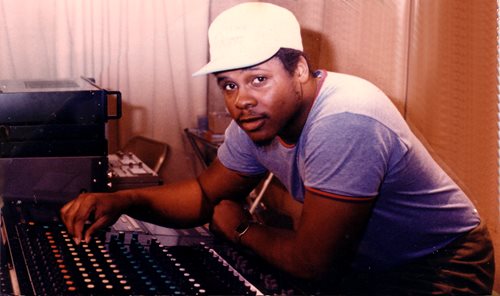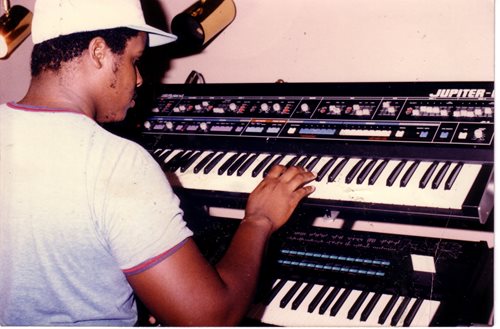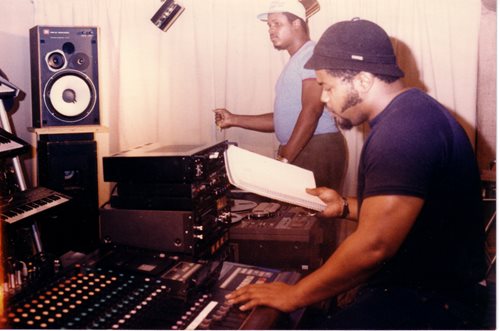
Legacy Series: Cozmo D and Newcleus
An interview with hip-hop pioneer and creator of "Jam On It"
Wikki Wikki. Shut up!
The sounds of rainfall and laughter. Ominous synths. A bass drum bounces like a freshly-pumped basketball. Pitch-shifted vocals that mimic a scratching record and shouting schoolyard taunts. Welcome to the world of Newcleus: Brooklyn-born hip-hop collective that came on like a lean electro cousin of P-Funk. Newcleus’ 1984 track “Jam On It” is ubiquitous. It appears in Beat Street and Dance Dance Revolution.
Like George Clinton’s merry music-makers, Newcleus was big on myth building. The group’s 1984 album Jam on Revenge even opens with an origin story about “a band of musicians from a far-off galaxy, a place where music and dancing are against all cosmic and computer law.” (Remember, during the Footloose-era the struggle against dancing was very real.) Finally, opener “Computer Age” kicks with a near-symphonic ensemble of panned synths and robotic vocals.
“Jam On It” is so dense with groove, creative production, and lyrical panache it couldn’t be contained by traditional pop lengths. Still, the song never feels a moment too long. The deliberate, delicate keyboard plinks evoke the New Romantic movement, while simultaneously predicting future acts like Santigold, Outkast, and Bruno Mars.
"Jam On It" follows the classic structure established by Sugar Hill Gang, even referencing Superman ala “Rapper’s Delight.” And those percussive sounds? The cutting claps and pitched cowbell so perfectly suited for a breakdown? Pure TR-808. In fact, Roland powered the whole “Jam On It” production. In addition to the 808, Cozmo D used a TB-303 for the sequencing and the RS-09 for chords
Around five minutes in, the beat gets vicious and the bass line pushes even harder against the 808. You can picture the kids popping and locking, gathered crowds clapping in time, all because Newcleus traveled the cosmos for a safe place to share their funk.
I'm Cozmo D from outer space, I came to rock the human race
I do it right 'cause I can't do it wrong
That's why the whole world is singin' this song

What are your thoughts on the current state of hip-hop music? Any particular favorites?
Well, in my opinion, what we have now are hip-hop and rap. Rap has very little divergence in style and substance. Most everybody sounds the same, using the same styles, flows and cadences, and the same subject matter. This disqualifies it from being hip-hop, as the #1 rule in hip-hop has always been not to bite someone’s style. There is still hip-hop to be found out there, but it mostly struggles to be heard.
What is it about “Jam On It” that has kept its fresh and appealing to new generations through games like Dance Dance Revolution, DJ Hero 2, and other outlets?
I wish I knew! I would bottle it up and then sprinkle some on everything I did! I think it has a lot to do with the fact that it was probably the most natural and impulsive track I've ever made. I came up with every aspect of the track and arrangement in about 45 minutes, and I am usually very slow. The track just drips with spontaneity and funky authenticity. Whatever it is, it’s been a blessing for a long, long time!
I like to think also that the rhymes, most of which were battle-tested in the parks of Brooklyn in the ’70s, were just simple and catchy enough to be timeless.

Can you tell us some of the history behind your development as a producer and musician?
When I first decided to try my hand at making my own music in 1979, I was an office messenger in a mailroom. I couldn’t afford any of the professional equipment that was out there. My first synth was an Electro-Harmonix Mini Synthesizer, a monophonic, toy-looking thing with membrane keys that was made out of cheap, thin plastic with a cardboard underside. My first drum machine was the first Boss (by Roland) Dr. Rhythm, which fit in the palm of your hand, but was actually somewhat programmable! That was all I had, so I would use two cassette decks and built my earliest tracks, tape to tape.
You’ve been very vocal about your appreciation for and creative use of Roland gear.
The cool thing about Roland was, they were making innovative instruments that were affordable. So, I saved up my money and bought a Roland RS-09, my first polyphonic synth (though it was basically mostly organ and string sounds), and a $5 beginner’s theory book, and started teaching myself scales and how to play chords. It’s probably due to the RS-09 that pads and long, sustained chords have always been prevalent in my music.
However, it was when Roland released the TR-808, and then the TB-303, that my music and my life would change. The immense programmability of those two instruments allowed me to lay down the beats and funky bass lines that were in my head. If I could think it, I could program it. Finally, I purchased a Sequential Circuits Pro One monophonic synth and retired the Electro-Harmonix Mini Synth. This would be my basic set-up for the entire Jam On Revenge album. People have often assumed that I used racks and racks of synths, but for the most part, that was it.
The only difference was exchanging the studio’s Oberheim DMX for the 808 on “Destination Earth (1999)” and “No More Runnin’” just to change the flavor a bit. By the time we recorded “No More Runnin’” I had purchased a Roland Juno 60, which I used instead of the RS-09. One of the things I am most proud of, is that after I bought the Pro One, I realized that I could use it for bass lines, thus freeing up the 303 to use as a very sophisticated and highly programmable arpeggiator. This is what I did on “Jam On It”, long before people would start to use the technique to make Acid records.
Did your setup change over time?
By the time it came to make the second Newcleus album, I'd made a little money and could afford some new equipment. MIDI had arrived, and my first MIDI sequencer was a Roland MKS-70. Among other synths, I bought a Roland Jupiter 6, a JX-3P, a TR-727, an MC-202, but perhaps the two most essential synths that I ever purchased, were the Roland Juno-106 and JX-8P. The strings, pads and horns on those two synths are so warm, fat, and luscious that they became irreplaceable to my music.
In fact, when I started doing house music in the late ‘80s, I built my entire Dream 2 Science project around those synths. In the ‘90s I made the foolish mistake of replacing all of my synths with modules, not appreciating the uniqueness in sound and feel that I would lose. I soon found that I could not replicate their warmth and feel no matter what I used. A few years ago, I finally gave in and bought a used JX-8P on eBay. Then the boutique JU-06 was released and I bought two of them! Now, of course, I have the Cloud. I'd love to see the JX-8P on there!
As a subscriber, tell us about your experience with the Roland Cloud.
I love the Cloud! These days, I use a lot of plug-ins anyway, so it fits right into my work flow. And, I now have access to the sound of synths that are long gone from my studio, like the SH-101 and the JX-3P, plus classics that I never had the pleasure of owning, like the Jupiter-8 and the TR-909. All for the price of a good cigar and nice dram of single malt scotch per month? And I get to keep two synths per year? Works for me! Waiting on you guys to add some of my long-lost favorites like the MKS-80, JD-990, Jupiter 6, and of course the JX-8P!
Newcleus and Jam-On Productions seem to stay constantly busy. Where does your work ethic come from?
I wish that I could claim a great work ethic, but that’s just not the case. I am, what I like to call myself, a “Professional Crastinator.” To a fault. It’s what I have been all my life. However, I seem to thrive under pressure. Put me up against a deadline and that is when I do my best work. As for us staying busy, I can only venture that is due to us remaining assessable and humble, and open to every opportunity and possibility.
You must have heard your influence on other artists over the years. Do any stand out in particular?
Where I have heard my influence often in hip-hop is when other artists sample us or use our music. It's an extremely flattering feeling and I always feel honored beyond belief. Sometimes they'll even throw in the "Wiki Wiki" voices. A few have even covered “Jam On It”, the one that stands out most is Yaslin Bey (Mos Def). I have always wanted to meet him and tell him how honored I am. In house music, the Dream 2 Science influence has been quite notable as well. Maybe it will be even more so now that I've spilled the beans on what synths I used!
Can you tell us a bit about the creative projects you are working on right now?
Right now, I am putting the finishing touches on the new Newcleus album, Jam-On Returns. I’ve actually been working on it for quite some time, but it finally is rounding into shape. It will be an album that covers every electro and hip-hop base from electro to electrofunk to boom-bap. It’s not old school though, it’s totally what I’m all about today. I also plan to release a new Dream 2 Science project in the near future.
Are you in contact with many of your peers from the golden era of hip-hop?
Yes, plenty of them. We do a lot of old school shows and tours. We also stay connected on Facebook.
You’ve been vocal about the influence of P-Funk on the early Newcleus aesthetic and sound. What other artists that were key in shaping your style early on?
For that electro synth sound, I was heavily into Giorgio Moroder, Jean-Michelle Jarre, Kraftwerk, and Gary Numan, but I was really heavier into funk on the music side. P-Funk, Stevie Wonder, Herbie Hancock, George Duke, Dexter Wansel, Jimmie Castor, Ohio Players, War, Mandre, and Junie Morrison.
These days, do you see yourself more as a rapper, producer, or combination? Does your songwriting process begin with beats or lyrics?
I’ve never really seen myself as a rapper. In the early days of hip-hop in the parks in Brooklyn, I would rap every now and then, but I was a DJ. We started out to be a hip-hop funk band, we had no intention of rapping, since both Chilly and I were DJs, not rappers. It was only after Jam On Revenge when the record label wanted us to do a rap record, that we did “Jam On It.” I guess that I now consider myself somewhat of a rapper, but I would never call myself an MC. I have too much respect for real MCs. Yeah, what I am, and have been since the beginning, is a producer. And, I am proud of it. My songwriting process almost always begins with a bass line. Every now and then it will start with a beat or a chordal progression. I never write the lyrics until after the music has told me what the song is about.
Based on your career, what advice would you give to aspiring rappers, beatmakers, and any artists looking to break into music in today’s climate?
I guess in this day and age, sounding like stuff that is already out there and successful is a winning formula, but I don’t know how long you can run with that. Whatever, I just know what works for me.
Find your own style and make your own lane. I get much satisfaction out of knowing that my music and style are mine alone.

Many feel that your work with Newcleus’ Jam On Revenge is a hip-hop classic on par with legendary albums of the era. How does it sound to you now? What are your thoughts on the process? Did you feel a bit of pressure?
My only way to describe how I feel about that album now is “appreciation.” Too many things happened in the making of it that don’t allow the memories of the process to be fond ones. They stripped the vocals off of “Destination Earth (1999).” They turned “Automan” and “No More Runnin’” into dubs. They added that horrible commercial track that wasn’t made by us, “Where’s The Beat,” to the album. But still, the music shone through, and that album has been nothing but a blessing to this day. So, nothing but appreciation from me. As for pressure? Nah, we had no idea what we were supposed to feel while we were making it. We just went for it.
Chilly B was your musical partner and you two must have experienced some incredible triumphs and challenges together. What was unique about his contribution to the Newcleus formula?
Especially during the making of the first album, Chilly wasn’t really involved with the core of the development of the songs. Chilly was playing bass in another band, so I started all of the tracks on my own. But Chilly was twice the musician that I was, and his ability was natural. He could hear something and pick right up on it, and our styles really complemented each other. So, often I would leave space on a track for his input, and what he would lay down would always take the song to another level. Imagine “Destination Earth (1999)” without the pad melody, or even “Computer Age (Push the Button)” without his synth solo, and those tracks would be truly diminished.
How does it feel when people find out that you were behind “Jam On It” and other Newcleus classics?
Like the British say: “chuffed!” I couldn’t feel more honored and blessed!
With songs like “Computer Age” and “I’m Not a Robot,” much of the messaging on Jam On Revenge seems to predict the tech-centric world we live in today. What would you think your teenage self think of the world today?
He wouldn’t think much of it, that’s for sure. I would like to think though, that even though I would feel it a duty to point out all the problems and what is wrong with the world, I would still be looking and grasping for whatever hope may exist. Sort of how I feel right now.
Anything else you’d like to share with Team Roland Cloud?
I just want to say thank you for being my favorite instrument company for the past nearly 40 years, never failing on the innovation, inspiration and price tip, and thank you for bringing the Cloud to us!
Follow Cozmo D and Jam-On Productions where the music
takes them.
Photos Courtesy of the Artist